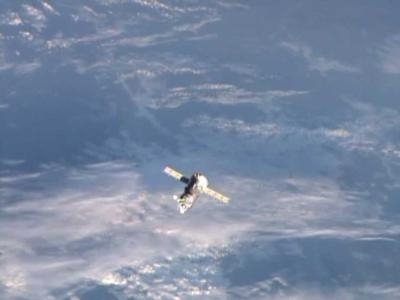Next Russian Freighter Expected To Arrive At Station Wednesday
A Russian space freighter departed the International Space Station Monday, clearing the way for the next express delivery of cargo on Wednesday.

The ISS Progress 55 cargo craft undocked from the Pirs docking compartment at 5:44 p.m. EDT Monday after spending more than three months at the orbiting complex. Progress 55 delivered nearly three tons of food, fuel and supplies when it arrived at the orbiting complex on April 9.
After undocking, the Progress moved to a safe distance away from the station for 10 days of engineering tests before it is deorbited on July 31. Now filled with trash and station discards, Progress 55 will burn up as it re-enters the Earth’s atmosphere over the Pacific Ocean.
The departure of Progress 55 clears Pirs for the arrival of the next Russian space freighter. ISS Progress 56 is scheduled to launch at 5:44 p.m. Wednesday from the Baikonur Cosmodrome in Kazakhstan (3:44 a.m. local time on Thursday), with about 5,700 pounds of food, fuel and supplies for the station's Expedition 40 crew. Progress 56 will make a four-orbit, six-hour trip to the space station and dock at 11:30 p.m.
The Progress 56 craft, atop its Soyuz booster, will roll to the launch pad at Site 1 at Baikonur early Tuesday for final pre-launch preparations.
In preparation for the arrival of Progress 56, Flight Engineer Alexander Skvortsov and Max Suraev began their workday Monday in the Zvezda service module with a practice session on the Telerobotically Operated Rendezvous System, or TORU. Russian vehicles dock to the station automatically through the use of the Kurs automated rendezvous system, but the crew can use TORU to manually guide a Russian spacecraft to its docking port if a problem arises.
Commander Steve Swanson and Flight Engineer Alexander Gerst spent much of their morning participating in medical tests to help flight surgeons track the effects of long-duration spaceflight on the human body.
Gerst drew a blood sample from Swanson for the Human Research Facility study, and Swanson processed the sample and stored it in the Minus Eighty-degree Laboratory Freezer for ISS, or MELFI, to preserve it for future analysis back on Earth.
Swanson and Gerst then participated in vision tests and measured the intraocular pressure of each other’s eyes for the Ocular Health study. NASA recently identified that some astronauts experience changes in their vision, which might be related to effects of microgravity on the cardiovascular system. In space, the body’s fluids tend to move toward the upper body and head and cause the pressure in the skull to rise. The increased pressure from the cranium travels down the optic nerve and affects the eye. NASA is working to understand and prevent these changes in astronauts, which in turn may help doctors diagnose and treat related vision changes here on Earth.
Swanson also teamed up with Flight Engineer Oleg Artemyev to set up hardware and collect data for a joint U.S. and Russian study of the ultrasonic environment of the station.
Meanwhile, Gerst assembled the Aquatic Habitat for the Zebrafish Muscle study, which is taking a look at the molecular changes that cause muscles to atrophy in microgravity. The Aquatic Habitat, consisting of two aquariums with a closed loop water circulation system, is capable of accommodating small freshwater fish, such as medaka or zebrafish, which serve as ideal models for vertebrates.

Flight Engineer Reid Wiseman focused his morning on setting up the Combustion Integrated Rack for more ground-commanded tests. This facility, which includes an optics bench, combustion chamber, fuel and oxidizer control and five different cameras, allows a variety of combustion experiments to be performed safely aboard the station.
Wiseman later conducted another session with a combustion experiment known as combustion experiment known as the Burning and Suppression of Solids, or BASS, inside the station’s Microgravity Science Glovebox. BASS is investigating the hypothesis that some materials may actually become more flammable in space, and the results from BASS will help screen materials for their use aboard future spacecraft. The research also provides scientists with improved computational models that will aid in the design of fire detection and suppression systems both in space and here on Earth.
Wiseman and Swanson took a break from their work to talk with NASA officials and Apollo astronauts gathered at the Kennedy Space Center in Florida for the renaming of the center's Operations and Checkout Building in honor of Neil Armstrong, The renaming ceremony included NASA Administrator Charles Bolden, Kennedy Center Director Robert Cabana, and Apollo 11’s Mike Collins, Buzz Aldrin and astronaut Jim Lovell, who was the mission’s back-up commander. Swanson and Wiseman spoke about how Apollo 11 personally inspired them and how the legacy of Apollo led to the space station and set the path for America's next giant leap to send astronauts to Mars.
(Images provided by NASA. Top: A video camera aboard the International Space Station captured this view of the ISS Progress 55 cargo craft shortly after undocking Monday.
Bottom: Flight Engineer Reid Wiseman works with the Combustion Integrated Rack aboard the International Space Station.)
 Aero-News: Quote of the Day (04.17.24)
Aero-News: Quote of the Day (04.17.24) ANN's Daily Aero-Linx (04.17.24)
ANN's Daily Aero-Linx (04.17.24) Airborne-Flight Training 04.17.24: Feds Need Controllers, Spirit Delay, Redbird
Airborne-Flight Training 04.17.24: Feds Need Controllers, Spirit Delay, Redbird Airborne 04.16.24: RV Update, Affordable Flying Expo, Diamond Lil
Airborne 04.16.24: RV Update, Affordable Flying Expo, Diamond Lil Airborne 04.11.24: SnF24!, King's 50th, Top Rudder, Aileronics
Airborne 04.11.24: SnF24!, King's 50th, Top Rudder, Aileronics




